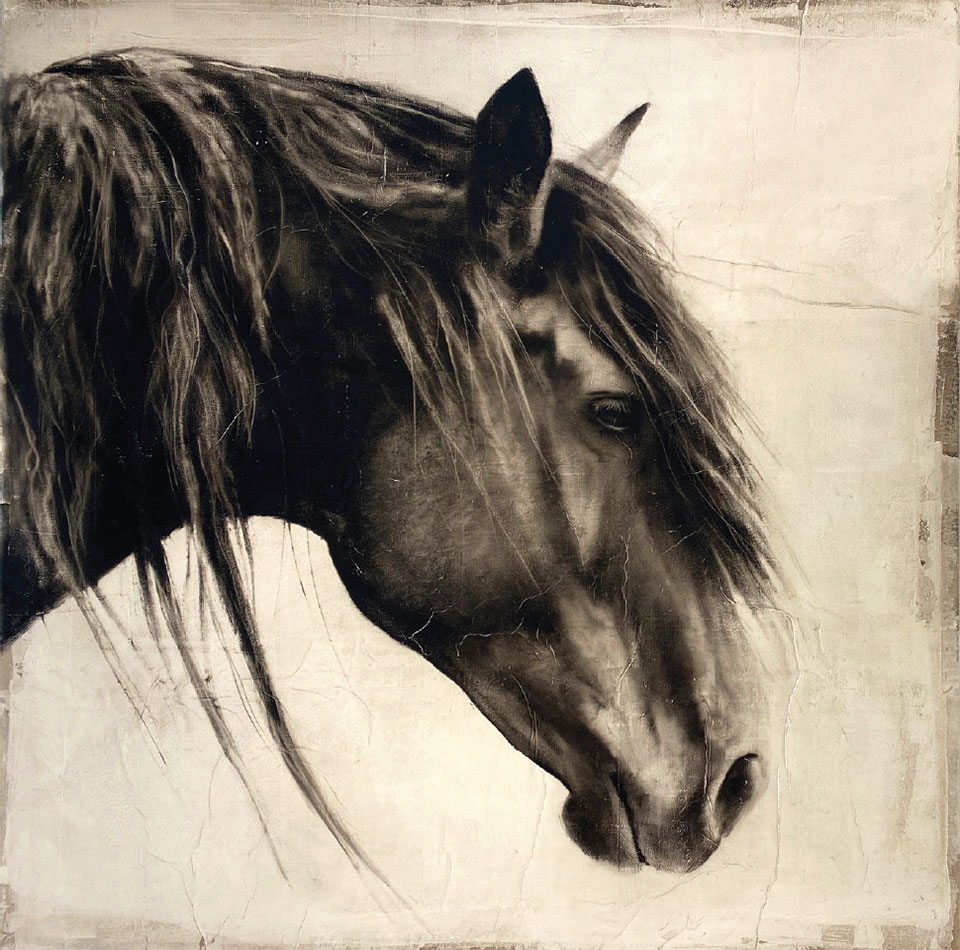Lived Experiences of Western Life
by Michele Corriel
Above: Day Dreaming | 36”x36” | Oil on Paper on Panel | Courtney Collins Fine Art
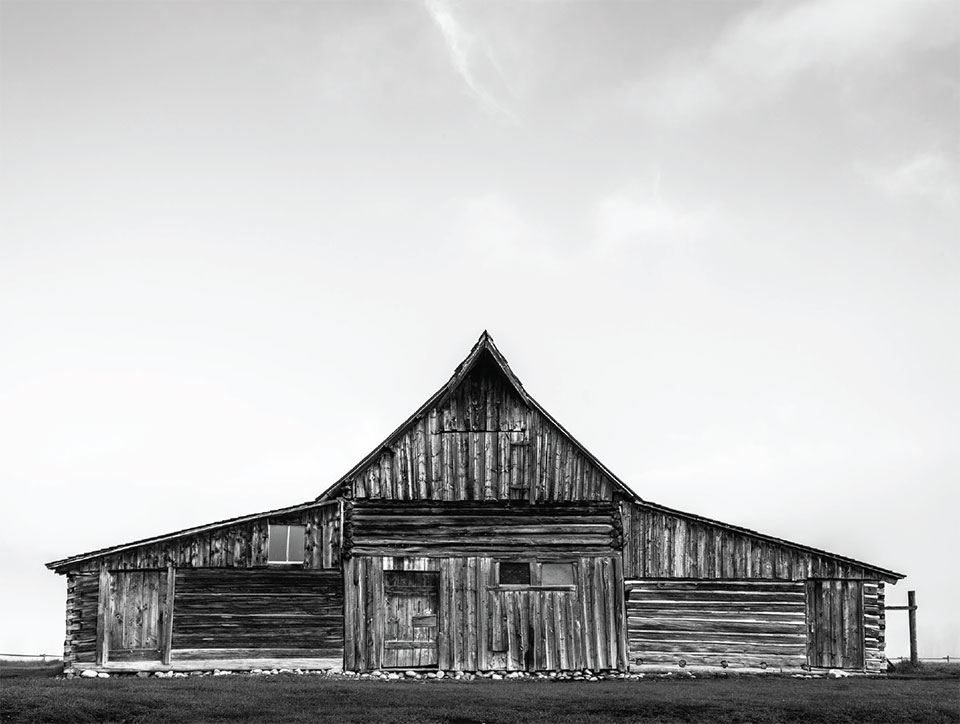
The Barn | Photography | Kevin Noble | Studio Noble
Being in and a part of Montana means a daily realization of the landscape and a moment-by-moment connection to place. The artwork in this feature shows how vital a role art plays. From the textured surfaces of Ken Peloke’s horses to the fine art photography of Kevin Noble, art speaks to the lived experiences of western life.
Color, too, plays a large role in expressing not only the natural exterior locations, but also the interior places of emotions. With shorter, darker days, longer quilted nights, and snowflakes softly sifting down, Montana winters offer downhill excitement and fireplace chats. Kira Fercho’s explosions of color convey her own personal narrative through layers of thickly applied oils, while Kimbie Noble’s acrylic portraits of wildlife speak to the intimate encounters along the way.
Whether your taste in artwork tends toward the complete spectrum or starkly to the black and white, the artwork featured in the next dozen pages welcomes in the cold months with a full heart. As the poet William Blake wrote, “In seed time learn, in harvest time teach, in winter enjoy.”
“In seed time learn, in harvest time teach, in winter enjoy.”
–William Blake
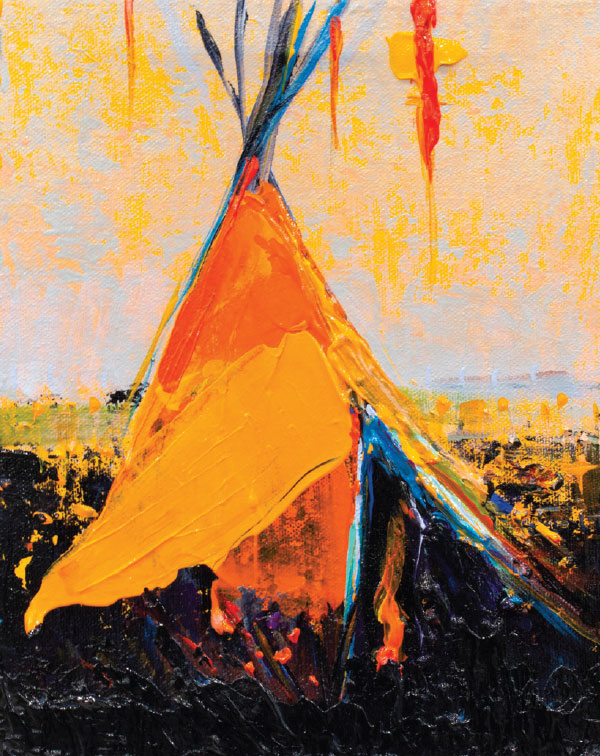
Many Blessings | 40” x 50” | Kira Fercho
Kenneth Peloke
A featured artist of Courtney Collins Fine Art
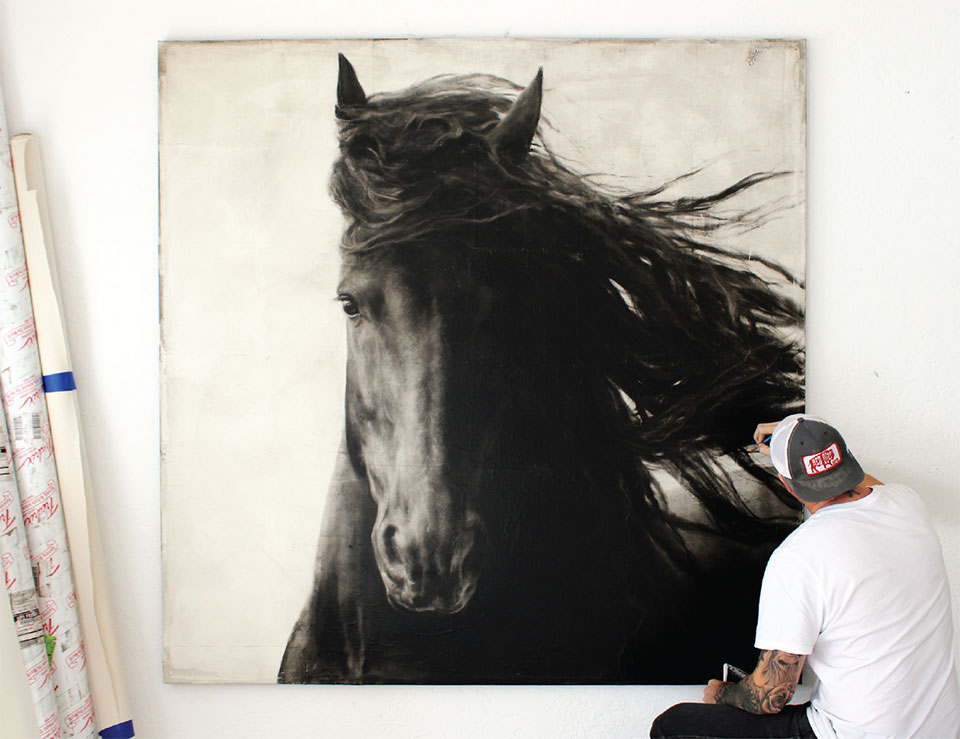
Passage | 72” x 72” | Oil on Panel
“I walked into a gallery in Jackson and saw one of his massive horse paintings. I was so overwhelmed by its intensity, the grace and beauty of the piece; it silenced
me with awe.”–Courtney Collins, Courtney Collins Fine Art
The first time Courtney Collins saw Ken Peloke’s large oil paintings she wanted to drop to her knees in admiration.
“I walked into a gallery in Jackson and saw one of his massive horse paintings,” Collins, owner of Courtney Collins Fine Art, Big Sky, says. “I was so overwhelmed by its intensity, the grace and beauty of the piece; it silenced me with awe. And I thought one day, if I were able to showcase and sell his work, that would be an immense career highlight. Ten years later I’m here and that’s actually what happened.”
Peloke’s large-scale oil paintings command attention. Not because of their size, but because of their presence. Through the textured surface and the distressed treatment of the layers, he creates a kind of wisdom, experiential knowledge that can only be learned by breathing in and out every day.
For Peloke, the first step in creating any painting is the image. “I have to feel the image,” he says. “It’s an emotional experience when I paint.”
Whether it’s the raw edges of nature or the purity of spirit, Peloke completely immerses himself in each painting.
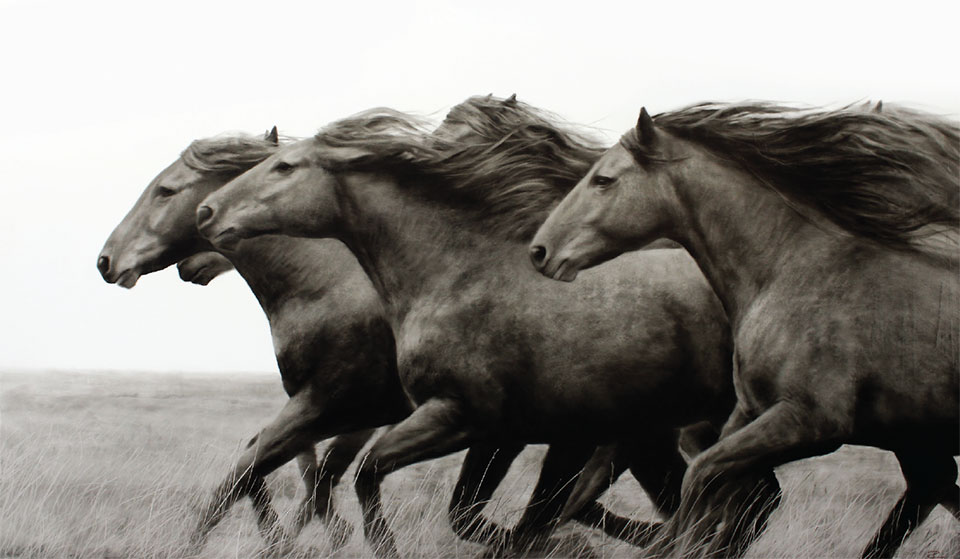
Free Rein | 48” x 83” | Oil on Panel
“Lately, I’ve been using photos from a photographer or from someone who has a horse farm because the photograph has so much to do with the finished piece,” he says. Although his paintings may look like photographs at first glance, upon closer observation they reveal a layered surface and a bit of abstract brushstroke and unfinished lines. “Once I have the photo, I change it into black and white. I usually mess with the images and then clean them up before I even start on a painting.”
Using wood panel, or a collaged type of Japanese paper pasted onto the wood panel, Peloke begins with the first of many strata.
“In the beginning I layer,” he says. “Once the layer is where I like it, I’ll start painting, which takes hours of focus.”
The intensity of his focus can be seen in the meticulous renditions of his horses. Rarely is a brushstroke visible, due to a lot of blending. “I try to get it to where it’s photographic from afar,” Peloke says. “I want people to think it’s a photograph at first glance. That’s the feeling I like.”
Once the piece is dry, he goes back in and rubs out half the surface, revealing textures and layers.
“I’ll go through and erase quite a bit of work, which brings the aging effect,” he says. “I’ve destroyed pieces doing this. In doing this, there’s this cool thing that comes out. At first, it happened by trial and error.”
The happy accident occurred when Peloke didn’t have much money and didn’t have many canvases or panels, so, if a painting wasn’t right, he would erase it. “It looked like it was burned or maybe printed a long time ago, and I was drawn to that,” he says. “I’ve stuck with that process since I’ve been professionally painting during the last 10 to 12 years.”
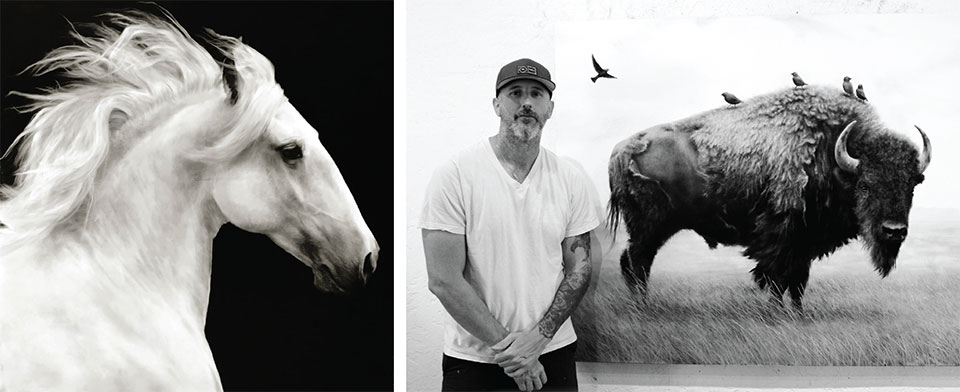
Left: Breakthrough | 48”x 48” | Oil on Panel.
Utopia | 48” x 60” | Oil on Panel.
The subject of the horse came about due to his wife’s love for them. “My wife is obsessed with horses and had been trying to get a horse of her own ever since I’ve known her,” Peloke says. If he couldn’t give her an actual horse, he thought he’d try to impress her with a painting of a horse. It worked.
While he was painting the horse, the owner of the gallery next to his studio saw the painting. “She asked if I was represented anywhere,” he says. “And I wasn’t. Then she asked, how many pieces do you have? And I answered, I have one.”
She took the horse, and one other painting he was playing around with, to her Sun Valley gallery. A week later, she called Peloke to say she had sold both his pieces. “I told my wife, and it was an amazing thing to experience, so validating to sell my art so quickly, and to have people respond to work,” he says. “There was that connection with the horses.”
The Pelokes now have two horses, one for his wife and one for his daughter.
Moving forward, Peloke’s aim is to go with his gut and not worry so much about what people think. He’s taking a month off to recharge, get out of his head, and maybe try some new things. “It took a bit of courage to take the break,” he says. “I’ve had these things in my head for years but haven’t had the time to get them out.”
It’s also the first year he’s turned down a show. “The last two years have been really busy. I’ve taken a bit of a break; it was much needed,” he shares. “I paint a lot, and I get in my comfort zone and things flow well. But I have to regroup, and recenter.”
He’s been doing some abstract figurative work, just to give his mind some time away from the tight drawings. These pieces are loose, some with only a few wide brushstrokes to hint at the figure of a cowboy.
“He cares about who represents his work, on a deep level, he cares that the person is passionate about his work. I want everybody to fall on their knees when they see his work like I did.”
–Courtney Collins, Courtney Collins Fine Art
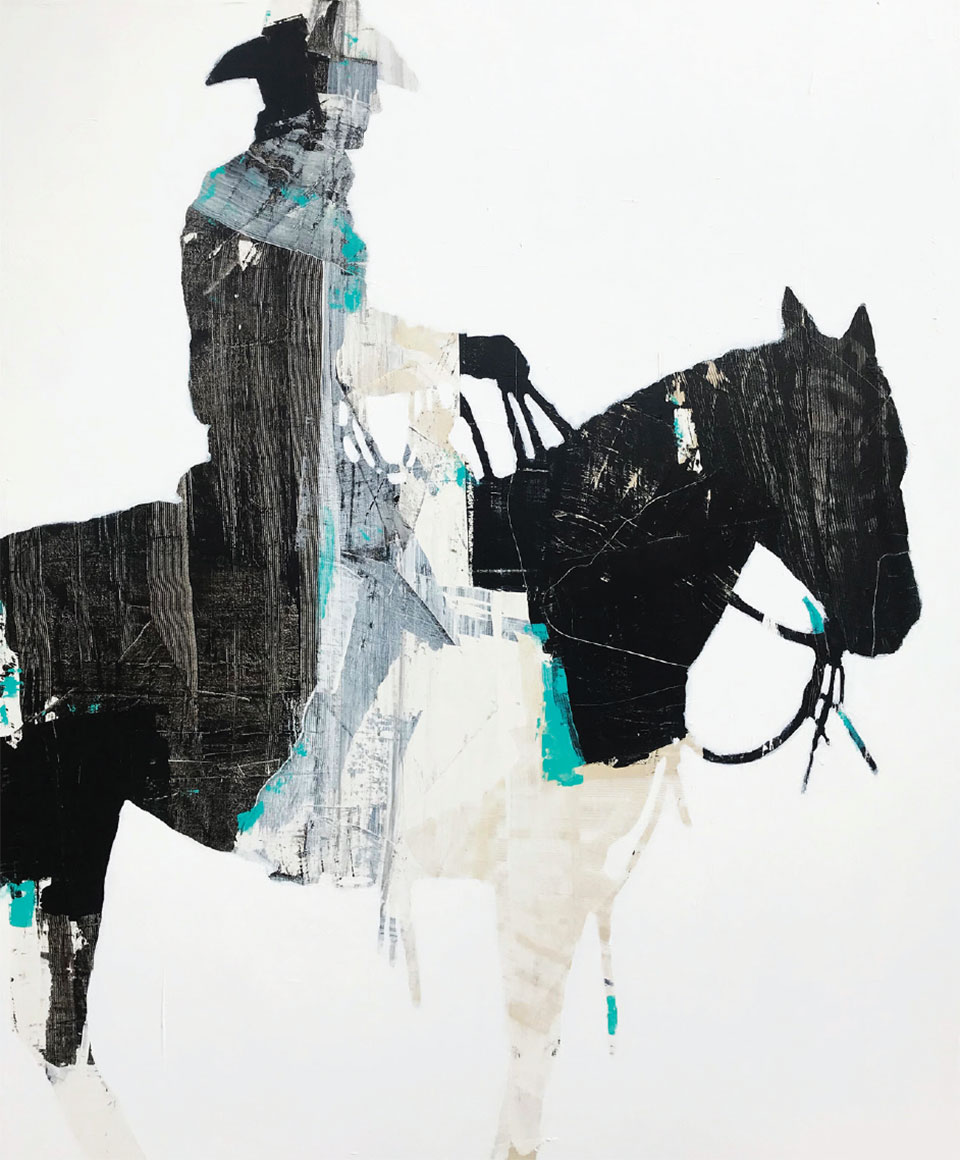
Gone Riding | 60” x72” | Acrylic on Canvas
“It’s a different side of my brain from the focused side,” Peloke says. “There’s an emotional connection with all my pieces; that’s who I am. Especially with animals. I capture a moment with the bison and the horses. With the cowboys it’s a bit more fun. The colors and patterns suggest a vibe that’s coming from the piece – it’s a different thing.”
The abstract paintings feel like a roll of the dice. There are layers and shadow, scraping and adding, that create a depth within the piece. These are condensed biographies, almost x-rays of the figure’s essence. The colors remain black, white, and some browns, but the simplicity of the paintings only adds to the mystique.
“I have no idea where these are going when I start,” he says. “It begins very abstract, then the lines get suggestive. It kind of just happens. It’s another process of layers and scraping, where something beneath is revealed. I love that feeling, that there’s always something deeper than the surface.”
Peloke has been represented by Courtney Collins Fine Art since she opened the gallery, in fact, his work was included in some of the first bodies of work she showed. “I love working with her,” Peloke says. “There are some people you meet when it’s just easy, and things flow. She’s very passionate about her artists. And she takes so much pride in that. That’s important to me. When she speaks to collectors, she represents me like I’m her own.”
Collins recalls her gallery opening with two or three of Peloke’s massive horse pieces and one of his abstract pieces. “That piece was blue like the sea – and the horses around it, and again I had that same feeling of awe to have his work in my gallery,” she recalls. “The surface is just so mesmerizing.”
Because Peloke is colorblind, he uses the surface to create color. This beckons to the viewer to ask, “What am I looking at?”
“Through trial and error, he’s made his colorblindness work for him, with layers and media,” Collins explains. “It plays a role in his work. I think it makes him a better artist because he uses that monochromatic palette to tell a story.”
Collins appreciates the depth and scope of Peloke’s work, both the horses and bison compare with the more abstracted figurative paintings. For collectors to have a piece of art on the wall that’s abstract is very different than the intensity of the subjective pieces. Many buy one of each, Collins notes.
“He cares about who represents his work, on a deep level, he cares that the person is passionate about his work,” she says. “I want everybody to fall on their knees when they see his work like I did.”
“It’s a different side of my brain from the focused side. There’s an emotional connection with all my pieces; that’s who I am. Especially with animals. I capture a moment with the bison and the horses. With the cowboys it’s a bit more fun. The colors and patterns suggest a vibe that’s coming from the piece – it’s a different thing.”
–Ken Peloke, Artist
Studio Noble
Kevin and Kimbie Noble
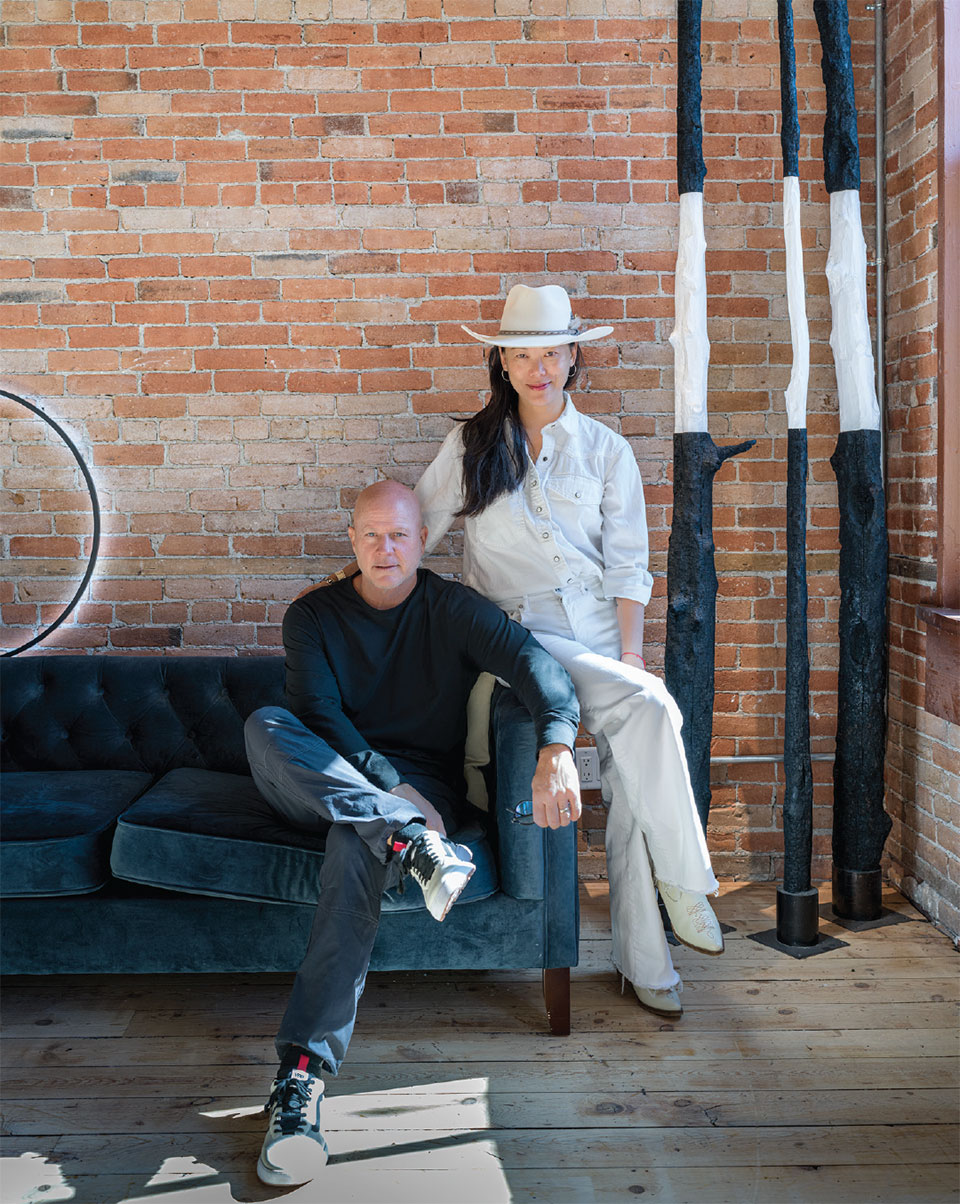
“We wanted space to breathe. This environment is speaking to Kevin’s style – his love of negative space.”
–Kimbie Noble, Artist, Studio Noble
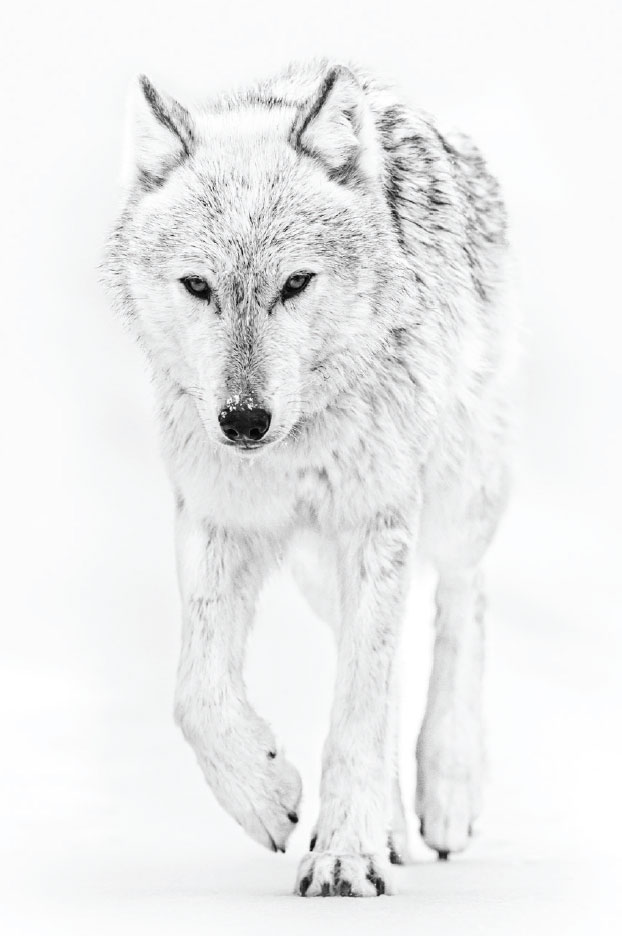
Dressed in White | Photography | Kevin Noble
Art couple Kevin and Kimbie Noble just opened Studio Noble upstairs from Old Main Gallery on Main Street in Bozeman. Kevin, a fine art photographer, and Kimbie, a painter, intend the space to be a showcase for their work.
Upon purchase of the building, the couple began the deep renovation of the little-used upstairs gallery, refinishing original wood floors, installing new lighting, and reconfiguring the entire space to accommodate Kimbie’s painting space and Kevin’s photography and portraiture studio.
Both artists come at the greater Yellowstone area from their own artistic perspectives.
“Our art is very different,” Kevin says. “It’s a cool combination.”
Kevin’s stark black and white, large-format photographs isolate subjects from a distance, focusing in on the yellow eyes of a black wolf, or the steaming beard of a bison. For the most part his images seem to contemplate the confines of a snow-laden winter, glimpsing wildness with a keen lens and a knowledgeable eye.
“My overriding principle is to choose the appropriate tools that suit my vision of the art in front of me,” he says. “I always try to look for a way to show the beauty of Yellowstone in an iconic style that perhaps the viewer hasn’t seen before. It’s an effort to create art that will stir emotion.”
Kevin’s black and white photographs cannot be ignored. Their presence and stark contrasts combined with his mesmerizing subject matter reach out across the space. His most recent work extolls the majesty of nature in a deeply personal, yet universal way. According to his artist statement, his aim is to create legacy art pieces that strip away the visual noise by using a minimalistic approach.
“Our art is very different. It’s a cool combination.”
–Kevin Noble, Artist, Studio Noble
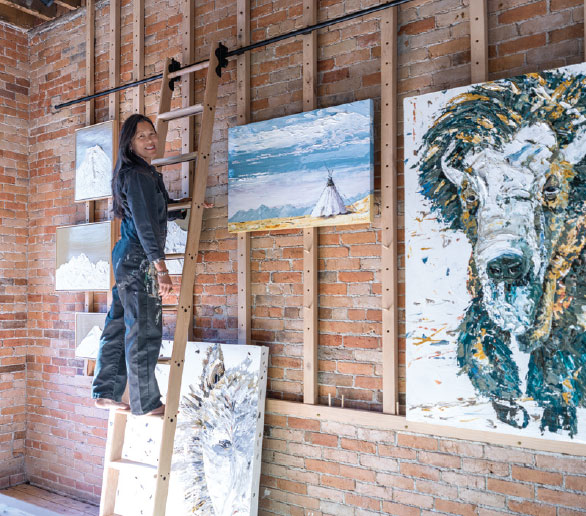
In his photograph Winter Wolf, an unforgiving snowy landscape creates distance between a stand of winter bare trees isolated with only each other for company, and the figure of a lone wolf. The overall image conveys a perfected solitude. Both the trees and wolf adapted to their environments – the trees still and silent, the wolf standing for a moment, as Kevin is able to catch it on film.
“Winter in the park is painted white, providing unique opportunities for framing distant shots of wildlife,” Kevin notes. “I followed this wolf for a couple hours, first by following the sound of her howling from deep in the trees, and finally as I tracked her across the Lamar Valley. The experience on this cold morning is one of my most memorable in Yellowstone.”
Kevin is as meticulous with his frames as he is with his photographs. Each of his images comes framed in a hand-crafted wood frame.
Kimbie’s impressionist thick impasto style helps to create what she calls “dimensional fine art” with extreme texture. Usually based on western wildlife, her palette knife portraits seem to jump from the flat plane of the canvas. Nearly a bas-relief of sorts, her works reference an almost sculptural presence.
The impetus for opening up Studio Noble was to give both artists their own separate work spaces while still offering opportunities to share and inspire each other.
“We wanted space to breathe,” Kimbie says. “This environment is speaking to Kevin’s style – his love of negative space.” So much so that they cut eye-level windows through the inner loft walls, creating natural viewing frames for the artwork. A frame within a frame, so to speak.
Kimbie’s studio is located at the street-side of the space, with four large windows allowing massive amounts of sunshine in.
“We’re going to hang some flowy curtains up to enhance the feeling of the studio,” Kimbie says. “And pegboards that give me the opportunity to hang my paintings, while being able to change them out in order to show my newest work.”
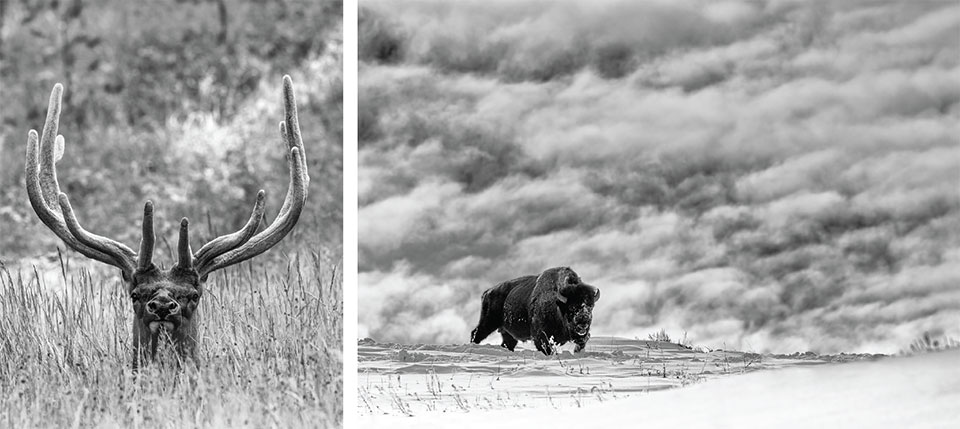
Left: Buck Up | Photography | Kevin Noble.
Right: Strength from Heavens | Photography | Kevin Noble.
Both Kevin and Kimbie can’t get over how perfectly the space works for them, in different ways. “We didn’t know exactly how perfect it was until we got in here,” Kimbie says. “I can’t wait to bring my paints in and start working.”
The guiding star for Kimbie is color. It’s what makes her smile. She incorporates color into her work through the use of palette knives, not brushes, which gives it the density and style she likes. “I used to paint very detailed and tight,” she says. “But once I discovered the palette knife, I just felt so free and was able to veer more to the impressionistic work that I love. My interpretation of the West is very loose, and people have really responded to it.”
Another aspect of the Studio Noble is Kimbie’s working relationship with Altitude Gallery, across the street. Altitude represents Kimbie’s work, but now, Amy Kirkland, owner of Altitude, has access to Studio Noble, even when no one is there.
Kirkland says the first thing that grabs her attention when looking at Kimbie’s work is the texture. “After the texture, then there’s the dynamic feel of each piece, how the clouds seem to come to life and the scenes welcome you to explore them,” she says. “It’s like you could just walk right into one of her paintings.”
“Collectors really respond to her work,” Kirkland continues. “Kimbie really captures the essence of our area and people who live here, or visit are immediately drawn to them. Her work is universally loved.”
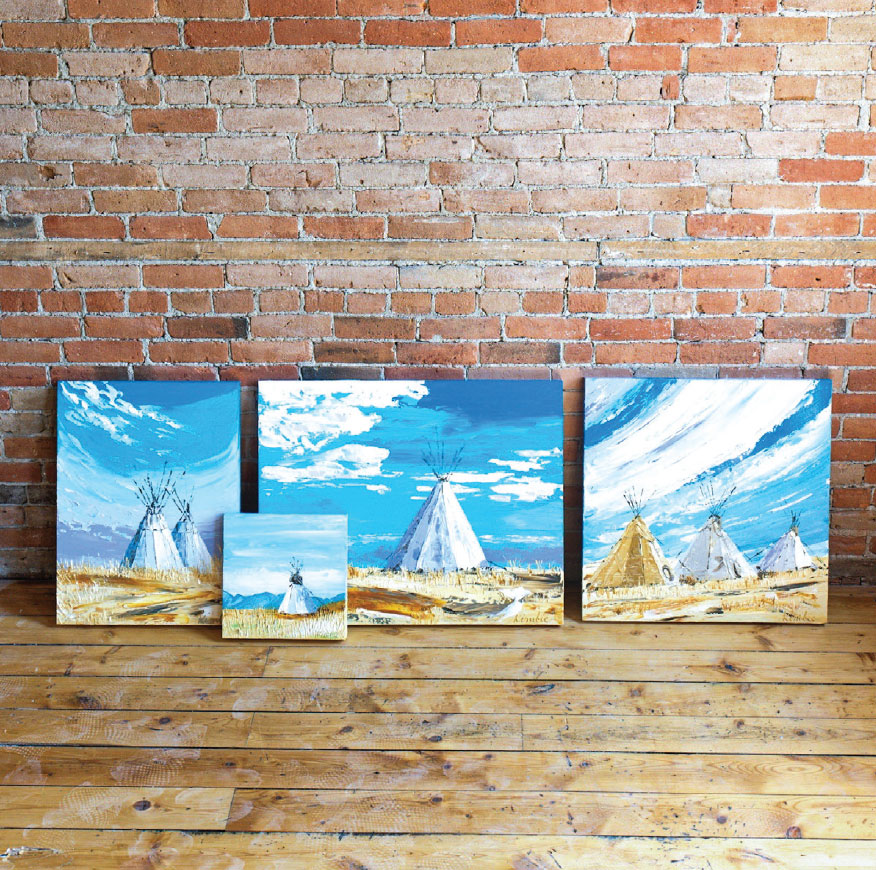
Mother Earth series. Heavy textured acrylic on wood. Kimbie Noble
“Our gallery space is tiny, but our customer base is quite large, so I think working together like this is a very natural fit. Plus, their new space is gorgeous, they’ve done a great job over there.”
–Amy Kirkland, Owner, Altitude Gallery
As far as Kirkland’s arrangement with Studio Noble, she thinks it’s a great relationship. “It feels like the perfect way to collaborate with someone who is already so giving and easy to work with,” she says. “Representing Kimbie is like being proud of your best friend; it’s easy to get excited about her work and want to show it off.”
Altitude Gallery has limited space, so offering larger pieces so close to the gallery is a great way to expand the options for someone who is interested in collecting Kimbie’s work, Kirkland says. “Our gallery space is tiny, but our customer base is quite large, so I think working together like this is a very natural fit. Plus, their new space is gorgeous, they’ve done a great job over there.”
The cooperative relationship between Altitude Gallery and Studio Noble works out for Kimbie as they love to travel. Last year they both went to Paris for three months, Kevin to study photography and Kimbie to study art.
“I wanted to learn all the things that I didn’t know,” Kevin says. “Honestly, I already knew most of it.” His experience wasn’t as rich as Kimbie’s. But he did pick up a few things that he can apply to his black and white photographs of greater Yellowstone, the photographs that put him on the map.
Kimbie went to the Studio Escalier where she took a lot of figure drawing classes. “My experience was completely different from Kevin’s,” Kimbie says. “We did live figure drawing three days in the studio with a nude model and two days at the Louvre.”
Upon their return from Paris, they restarted their search for a great space on Main Street that would work as a studio for Kimbie and a showroom for Kevin. “We’d been looking for something like this for years,” Kevin says. “We had a really hard time finding the right place.”
It just worked out, as things often do, that a building on Main Street went on the market at the just right time for the Nobles. “We were able to purchase an existing gallery space, the Old Main Gallery building. The Old Main Gallery business remains owned by Lindsey McCann and Micah Jastram and we have gotten occupancy of the upper floor.” Kevin says. “Between Old Main at street level and Studio Noble on the second floor, the building is an art destination on Main Street.”
Many of their clients and collectors are interior designers, who like the idea of a private showing space where they can ponder their own clients’ needs with the artwork before them. “We didn’t start out thinking of selling to interior designers, but it’s worked out well for us,” Kevin adds. Especially with the new studio space and the ability to access the works when the Nobles are out of town. “We want it to feel like our showroom is your showroom.”
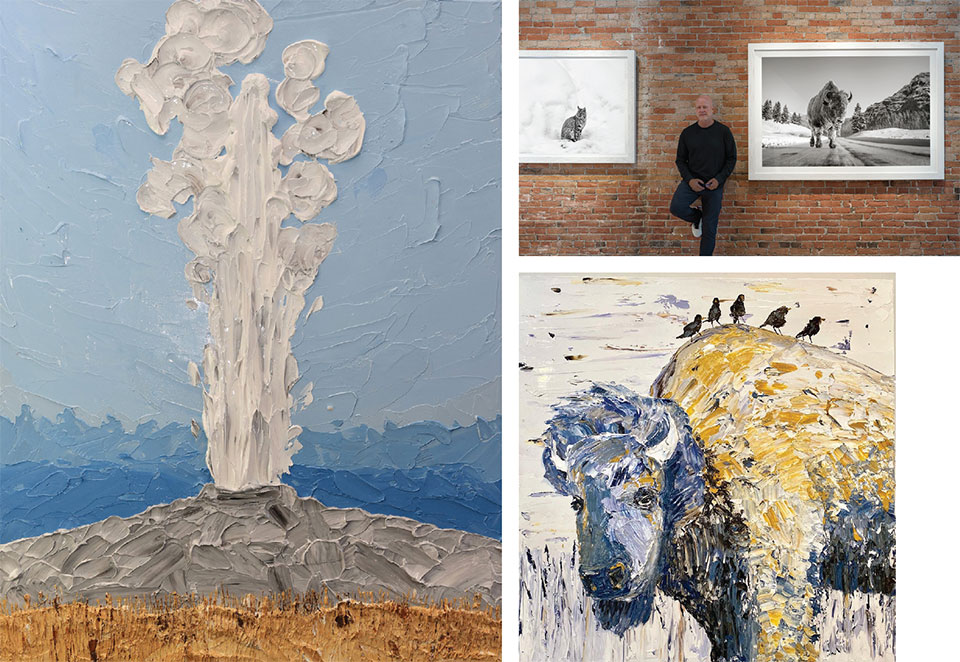
Left: Faithful | Heavy textured acrylic on wood | Kimbie Noble.
Right: Along for the Ride | Heavy textured acrylic on wood | Kimbie Noble.
Kira Fercho
Painting What She Knows
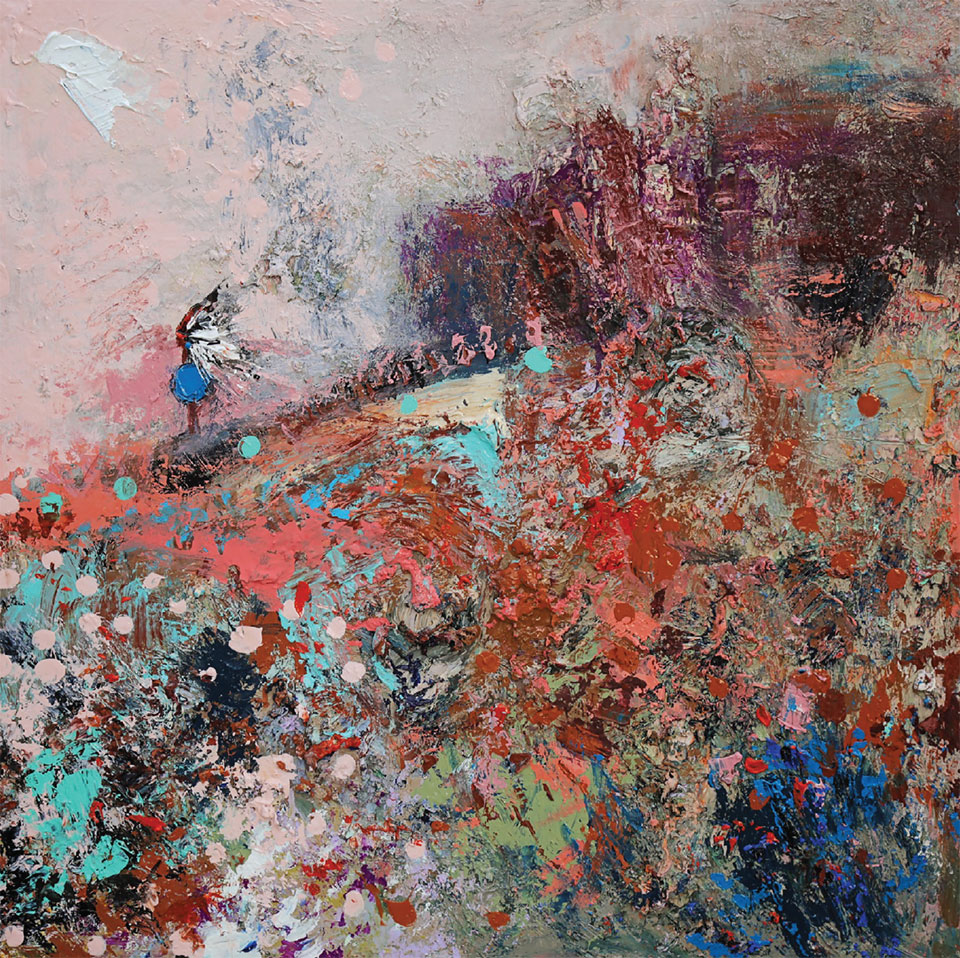
Warrior Meditation | 40” x 40” | Kira Fercho
“Warrior Meditation” (shown above)
“This piece is among the top ten favorite pieces that I have ever done. The palette is bold and a bit feminine: millenial pink/coral vs. aqua and burnt sienna. I had to soften the piece because the overall composition and feel is very masculine. The texture is rough and jagged. The subject and the land are from the Billings area where I grew up and live. The warrior is Crow and the backdrop is a part of the rims that is close to my home.”
–Kira Fercho, Artist
Impasto bursts of color sketch the history of Kira Fercho’s childhood in Montana. Her past merges with paint; her memories change forms and create a narration across the canvas.
“I make my ordinary extraordinary by using colors,” she says. “The rimrocks feel like sea glass to me with billions of colors, like sand under a microscope – there’s pink and red, blue and every color. That’s how I’ve always viewed the rims.”
Montana’s culture is part and parcel of Fercho’s life and work. In many ways, she feels that the rest of world has finally caught up.
“I grew up with 20-year-old pick-ups, and now it’s really cool,” she says. “We had to take care of the animals before and after school, had huge gardens, and in the fall, we canned everything. I thought my parents were so old-fashioned, but in actuality they naturally taught us how to be more resourceful and how to understand our culture, to embrace the land and where food comes from.”
That deep appreciation of place comes through in her work. Especially in “Rope the Moon” (shown top left), where a rancher on horseback is set among the roaming Black Angus cattle. The scene may be reminiscent of stories heard before, but the wild kaleidoscope of colors, the teeming landscape alive with wildflowers, grasses, mud, and water refer not only to the movement of the horse and cattle, but also to the constant movement of nature.
“I’ve been fortunate that Montana has become so popular,” Fercho says. “People are not just visiting, taking a few photos and leaving, but they really want to know about Montana.” She enjoys sharing her home state through her work. Especially the eastern Montana landscape.
“I call them blue collar chic,” she jokes. On the more serious side, she loves the openness of the eastern part of the state, saying, “The idea that there isn’t a ton of people around. I appreciate being from rural Montana and being able to come home and have breathing space and find peace naturally.”
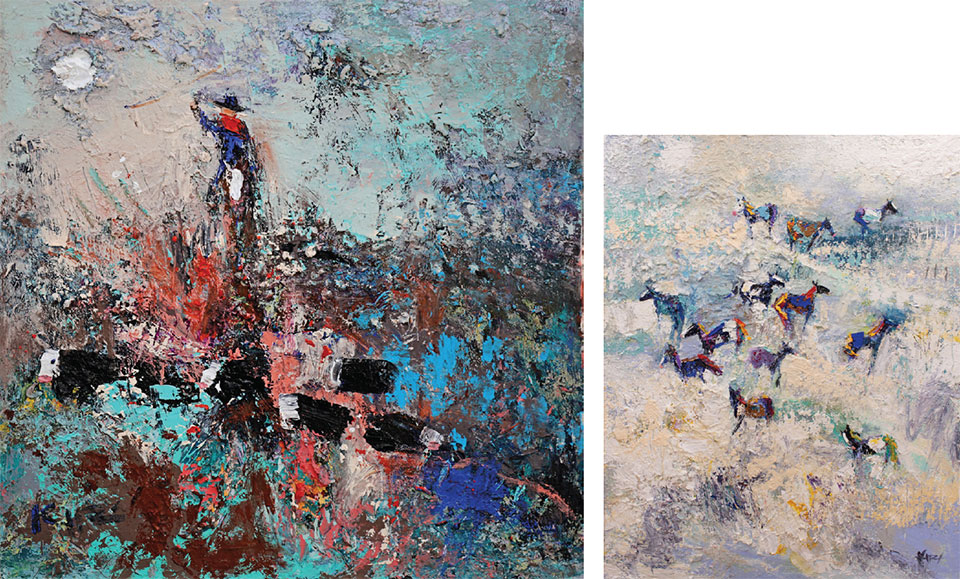
Left: Rope the Moon | 40” x 40” | Kira Fercho.
Right: Horses Play in Snow | 4’ x 5’ | Kira Fercho.
“I’m painting the things that are mine, the horses outside my studio, my friends’ tipis. Now it’s more of a personal narrative. It gets closer to the things I know.”
–Kira Fercho, Artist
With over 20 years of painting under her belt, Fercho has tackled the landscape, tipis, horses, people, but these days she’s making it more about her own personal experiences of living in Montana.
“I’m painting the things that are mine, the horses outside my studio, my friends’ tipis,” she says. “Now it’s more of a personal narrative. It gets closer to the things I know.” This kind of personal artistic expression reflects her own voice, which comes through louder than in previous years. It rings with a connection to the land.
“This last year I’ve been painting the rims, from a personal perspective, how I feel about them,” she says. “I’ve lived by them for years and I can see them from my window. Painting is more about feeling than about a strict rendition of a scene. I’m painting parts of them – they’re a background in my painting of cattle and Native Americans.
“The paintings are more about space – and the nomadic humans that have been roaming through here for quite some time. This area has always been nomadic. That’s the feel of this place., Montana is so free. And that’s why people love this state so much – it’s a free-riding spirit.”
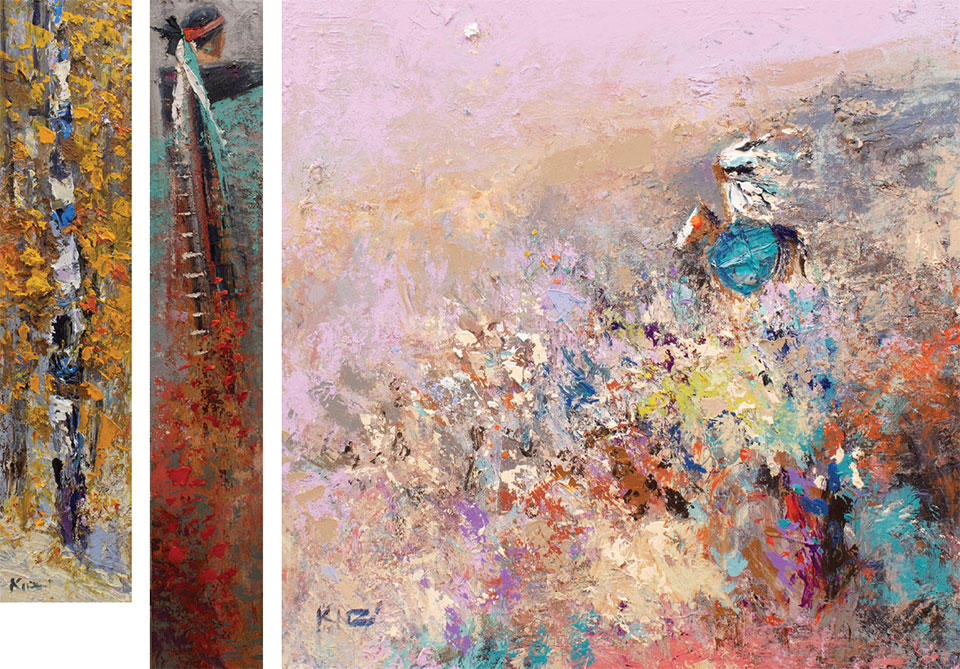
Left: Aspens | 1.5’ x 7’ Kira Fercho.
Center: Mother | 1’ x 6’ | Kira Fercho.
Right: Meditation | 40” x 40” | Kira Fercho.
Many of her paintings are commissions, all are originals, with no prints.
“I am a builder by heart, my dad was in construction, and I grew up with that,” she says. “In my mind, I think how that room could be more modern-looking … I love looking at different architect’s work, going into homes and seeing what they’ve done. I don’t want my paintings to scream off the walls, but they should be noticed – like the cherry on top.”
Fercho also builds all of her own frames and stretches her own canvases. “I’m always concerned about fine finishes,” she says. “My pieces are in tune with the homes they go into.”
In terms of the market, her prices are obtainable. And that encourages collectors to buy more than a single painting. “I have personal relationships with most of my collectors, who usually have three to five pieces,” Fercho says. “These people can buy any painting they want but they choose to buy mine. My commission clients are discerning and have an idea of what they want. I feel like I’m a vehicle for those. About 80 percent are commission. But I keep one day a week to paint what I want to paint.”
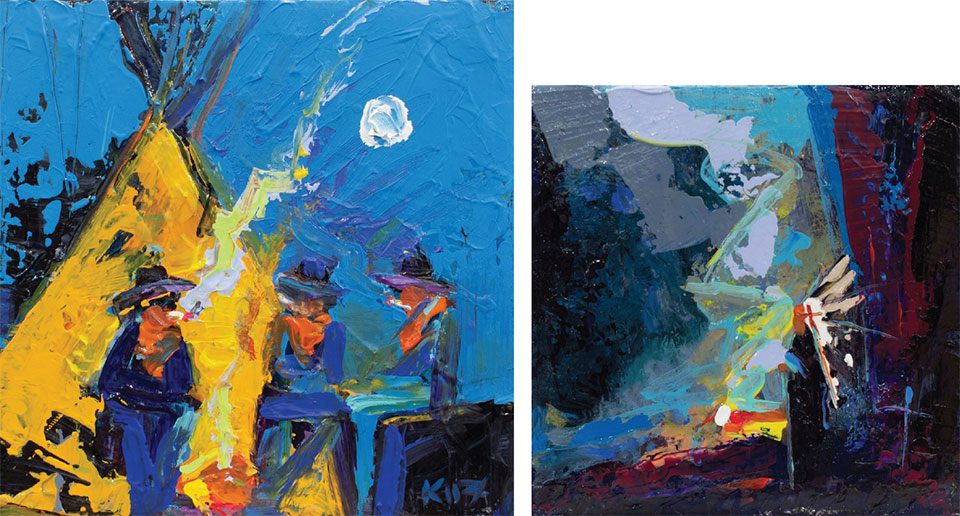
Left: Camp Stories | 60” x 60” | Kira Fercho.
Right: Healing Journey | 40” x 40” | Kira Fercho.
Pre-COVID, Fercho was doing a lot of shows, traveling a good deal and pressuring herself to produce. After the pandemic, she figured out she was happiest working in her studio.
“I’m a studio rat, with a sloppy bun and covered with paint, and I told myself that’s where 90 percent of life would be spent,” she says. “Now I’ll take a little trip here and there to hang out with my clients or friends. I took a different mentality, I quit trying to make a sale. Then I started to receive energy. If I sell something that’s fine, if I don’t that’s fine. Maybe this day is not about sales, maybe it’s about painting, or mental health.”
Fercho is presently in the process of building a new studio/gallery, which will consist of two buildings right next to each other, on the far west end of Billings, along the river. “I picked that area because it looks like where I grew up,” she says. “But it’s very easy to get to, it’s peaceful and quiet. We’re hoping to get it up by spring or summer.”
She tried having a studio in her gallery and she tried having a gallery in her studio, but neither one really worked for her. “I’m either in one part of my brain or the other. My studio, I keep tidy, but I work on seven paintings at a time. I have to take my done paintings out of the studio to get some emotional distance from them.”
The gallery will be built as a modern farmhouse, so people can see how the paintings look hung up in a home and how to use them. Her studio will be right next door.
She started to make free-standing totem paintings, which people loved but could not imagine how to show them in a home. “In the gallery/farmhouse space you can see how they look placed in a house,” she explains. “It makes it more interactive and will allow people to see a piece as if they are in a design studio. I can go through blueprints or plans, look at where paintings might make sense.”
Kira Fercho’s work intones the calluses of hard work, the rich anecdotes of rural life, and the deep understanding of Montana. Through color, form, and narrative, her paintings reveal the land’s constant beating heart.
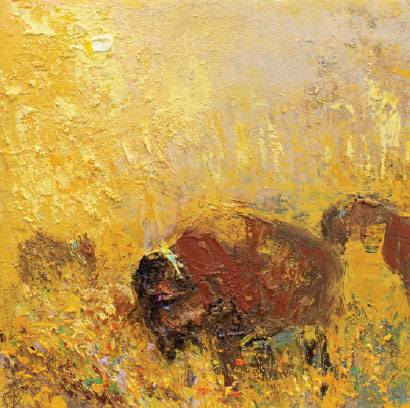
Kings of Yellowstone | 6’ x 6’ | Kira Fercho.
